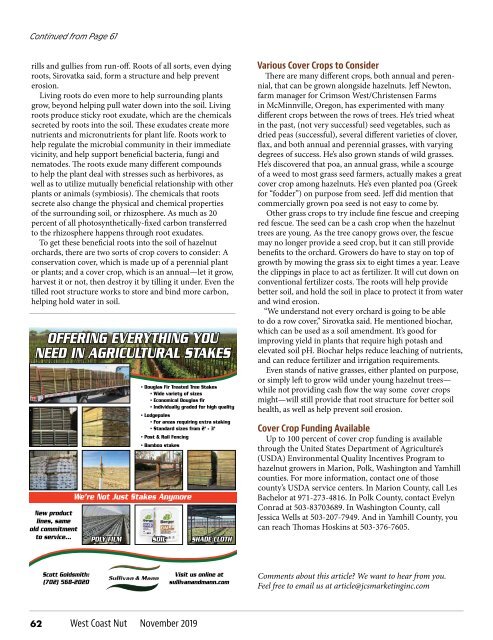You also want an ePaper? Increase the reach of your titles
YUMPU automatically turns print PDFs into web optimized ePapers that Google loves.
Continued from Page 61<br />
rills and gullies from run-off. Roots of all sorts, even dying<br />
roots, Sirovatka said, form a structure and help prevent<br />
erosion.<br />
Living roots do even more to help surrounding plants<br />
grow, beyond helping pull water down into the soil. Living<br />
roots produce sticky root exudate, which are the chemicals<br />
secreted by roots into the soil. These exudates create more<br />
nutrients and micronutrients for plant life. Roots work to<br />
help regulate the microbial community in their immediate<br />
vicinity, and help support beneficial bacteria, fungi and<br />
nematodes. The roots exude many different compounds<br />
to help the plant deal with stresses such as herbivores, as<br />
well as to utilize mutually beneficial relationship with other<br />
plants or animals (symbiosis). The chemicals that roots<br />
secrete also change the physical and chemical properties<br />
of the surrounding soil, or rhizosphere. As much as 20<br />
percent of all photosynthetically-fixed carbon transferred<br />
to the rhizosphere happens through root exudates.<br />
To get these beneficial roots into the soil of hazelnut<br />
orchards, there are two sorts of crop covers to consider: A<br />
conservation cover, which is made up of a perennial plant<br />
or plants; and a cover crop, which is an annual—let it grow,<br />
harvest it or not, then destroy it by tilling it under. Even the<br />
tilled root structure works to store and bind more carbon,<br />
helping hold water in soil.<br />
OFFERING EVERYTHING YOU<br />
NEED IN AGRICULTURAL STAKES<br />
New product<br />
lines, same<br />
old commitment<br />
to service...<br />
POLY FILM<br />
• Douglas Fir Treated Tree Stakes<br />
• Wide variety of sizes<br />
• Economical Douglas fir<br />
• Individually graded for high quality<br />
• Lodgepoles<br />
• For areas requiring extra staking<br />
• Standard sizes from 2" - 3"<br />
• Post & Rail Fencing<br />
• Bamboo stakes<br />
We’re Not Just Stakes Anymore<br />
SOIL<br />
SHADE CLOTH<br />
Various Cover Crops to Consider<br />
There are many different crops, both annual and perennial,<br />
that can be grown alongside hazelnuts. Jeff Newton,<br />
farm manager for Crimson West/Christensen Farms<br />
in McMinnville, Oregon, has experimented with many<br />
different crops between the rows of trees. He’s tried wheat<br />
in the past, (not very successful) seed vegetables, such as<br />
dried peas (successful), several different varieties of clover,<br />
flax, and both annual and perennial grasses, with varying<br />
degrees of success. He’s also grown stands of wild grasses.<br />
He’s discovered that poa, an annual grass, while a scourge<br />
of a weed to most grass seed farmers, actually makes a great<br />
cover crop among hazelnuts. He’s even planted poa (Greek<br />
for “fodder”) on purpose from seed. Jeff did mention that<br />
commercially grown poa seed is not easy to come by.<br />
Other grass crops to try include fine fescue and creeping<br />
red fescue. The seed can be a cash crop when the hazelnut<br />
trees are young. As the tree canopy grows over, the fescue<br />
may no longer provide a seed crop, but it can still provide<br />
benefits to the orchard. Growers do have to stay on top of<br />
growth by mowing the grass six to eight times a year. Leave<br />
the clippings in place to act as fertilizer. It will cut down on<br />
conventional fertilizer costs. The roots will help provide<br />
better soil, and hold the soil in place to protect it from water<br />
and wind erosion.<br />
“We understand not every orchard is going to be able<br />
to do a row cover,” Sirovatka said. He mentioned biochar,<br />
which can be used as a soil amendment. It’s good for<br />
improving yield in plants that require high potash and<br />
elevated soil pH. Biochar helps reduce leaching of nutrients,<br />
and can reduce fertilizer and irrigation requirements.<br />
Even stands of native grasses, either planted on purpose,<br />
or simply left to grow wild under young hazelnut trees—<br />
while not providing cash flow the way some cover crops<br />
might—will still provide that root structure for better soil<br />
health, as well as help prevent soil erosion.<br />
Cover Crop Funding Available<br />
Up to 100 percent of cover crop funding is available<br />
through the United States Department of Agriculture’s<br />
(USDA) Environmental Quality Incentives Program to<br />
hazelnut growers in Marion, Polk, Washington and Yamhill<br />
counties. For more information, contact one of those<br />
county’s USDA service centers. In Marion County, call Les<br />
Bachelor at 971-273-4816. In Polk County, contact Evelyn<br />
Conrad at 503-83703689. In Washington County, call<br />
Jessica Wells at 503-207-7949. And in Yamhill County, you<br />
can reach Thomas Hoskins at 503-376-7605.<br />
Scott Goldsmith:<br />
(702) 568-2020<br />
Visit us online at<br />
sullivanandmann.com<br />
Comments about this article? We want to hear from you.<br />
Feel free to email us at article@jcsmarketinginc.com<br />
62<br />
West Coast Nut <strong>November</strong> <strong>2019</strong>


















